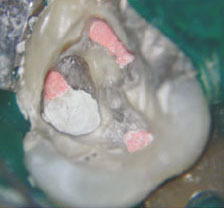


Some dentists justify not using rubber dam by declaring that since the tooth is ravaged by caries or by trauma it is impossible to place a clamp around the crown. According to the author’s opinion, whenever isolation with rubber dam isn’t possible, the clinician has two options: one is to make it possible, the other is to extract the tooth ! There are no other choices. It seems incredible that even today, two centuries later and now living in the third millennium, that there are still some colleagues who aren’t convinced of the usefulness, or rather, the necessity of this simple sheet of rubber and that the Scientific Associations that are in charge of laying down the “Guide Lines” haven’t included the rubber dam as a mandatory requisite during the practice of Endodontics ! The Quality Assurance Guidelines proposed by the American Association of Endodontists establishes that “cleaning, shaping, disinfection and obturation of all canals are accomplished using an aseptic technique with rubber dam isolation whenever possible”.

There is no doubt that placing the rubber dam, 150 years ago, was quite challenging, but today it requires only a few seconds and a minimum amount of instruments. Barnum could see us now, he would definitely tear his hair out…!!! Its quite incredible that after such a long period of time we are still discussing if the rubber dam is or is not necessary in Endodontics. Elliot introduced a set of metal clamps for different teeth.Ī good 150 years have passed since that distant day and if Dr. And that is how the rubber dam came to be.”Īt the time, trying to keep the rubber around the tooth was quite problematic, but things would soon improve a few years later, when in 1882 S.S White introduced a rubber dam punch which is similar to the one that is still in use now and when, in the same year, Dr. Desperate and eager to try a new idea, I made a hole in my protective napkin and placed it around the tooth. I had passed many sleepless nights obsessed over my sad failure….asking myself the same old question, that had yet to be answered: “How can I keep a cavity dry ?” The answer revealed itself on the 15th of March, 1864, while I was working on a lower left molar, in a mouth in which saliva was flowing everywhere. I had passed hours, tired and distracted by my incessant struggle against unending saliva contamination. It was the result of my torment caused by saliva. “At the time, when the concept of a rubber dam was forming in my mind, I was practicing in Monticallis, Sullivan Co., New York. Sanford Christie Barnum from New York wrote:


 0 kommentar(er)
0 kommentar(er)
